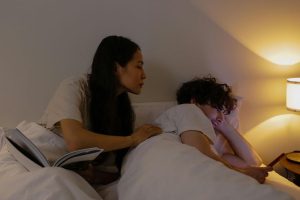Understanding and Coping with Separation Anxiety in Children
As parents, we want nothing more than to see our children grow up into confident, independent adults. But what happens when our little ones can’t bear to be separated from us, even for a moment?
Separation anxiety is a common issue that affects many children, especially during their early years. But with a little understanding and some helpful coping strategies, we can help our children overcome their fears and gain the confidence they need to thrive.
Causes of Separation Anxiety
Our brains develop rapidly during childhood, and this can sometimes lead to a fear of separation. Children may feel that they need to be with their parents in order to stay safe, and this can result in clinginess and anxiety.
Additionally, children crave time with their parents, and the idea of being away from them can be distressing. Another factor that can contribute to separation anxiety is permanency.
Young children may not fully understand the concept of time, and the idea of being separated from their parents can feel like an eternity. This can lead to feelings of panic and distress.
Factors that Influence Separation Anxiety
- New situations, such as starting daycare or school, can trigger anxiety in children who are already prone to separation anxiety.
- Family stress or traumatic events can also exacerbate separation anxiety, making it even harder for children to cope.
- Overprotective parents can unintentionally reinforce separation anxiety in their children.
- When parents are overly anxious about leaving their children in the care of others, children can pick up on this and feel even more anxious themselves.
- Similarly, parents who experience their own anxiety can inadvertently transfer it to their children.
Coping with Separation Anxiety
Fortunately, there are many strategies we can use to help children cope with separation anxiety. Reassurance is key – children need to know that they’ll be safe and cared for even when we’re not with them.
Talking through the separation with our children can also help. Letting them know what to expect and what will happen before, during, and after the separation can give them a sense of control and empowerment.
Preparation is also important. Practicing short separations in advance can help children build their confidence and get used to the idea of being away from us.
Establishing a routine can also help – when children know what to expect and feel comfortable with their surroundings, they’re more likely to cope with separation better.
Recognizing Separation Anxiety Disorder
While separation anxiety is a normal developmental phase, some children may experience more severe symptoms that interfere with their daily lives. This is known as Separation Anxiety Disorder (SAD) and requires intervention from a mental health professional.
Symptoms of Separation Anxiety Disorder
- Excessive anxiety, constant worry, and fear of leaving or being left.
- Struggle to sleep, experience physical symptoms such as headaches or stomach aches, and avoid leaving home.
Diagnosis of Separation Anxiety Disorder
If you suspect your child has SAD, it’s important to seek evaluation from a psychologist or mental health professional. A diagnosis of SAD may involve a review of the child’s medical history, a physical exam, and a psychological evaluation.
Once diagnosed, treatment can be tailored to the child’s specific needs.
Treatment of Separation Anxiety Disorder
Treatment for SAD may involve individual counseling, family therapy, and education. Cognitive-behavioral therapy, which helps children learn how to identify and challenge anxious thoughts, can be especially effective.
Some children may also benefit from medication under the supervision of a doctor. In conclusion, separation anxiety is a common issue that many children face.
While it can be challenging, it’s important to remember that it’s a normal part of development. By understanding the causes and factors that influence separation anxiety, we can help our children cope and thrive.
If you suspect your child has Separation Anxiety Disorder, don’t hesitate to seek help from a mental health professional. With the right support, our children can overcome their fears and become the confident, independent adults we know they can be.
Practical Strategies for Parents
Coping with Separation Anxiety at Night
As parents, one of our biggest challenges can be dealing with separation anxiety at night. Children may feel anxious about being alone in their beds without the comfort of their parents.
It’s important to reassure them that they are safe and loved, but it’s also crucial to be firm and set boundaries. Here are some practical strategies to try:
- Reassure your child: Let your child know that they are loved and safe, even when they are sleeping alone. Offer reminders of all the fun activities and experiences they had that day, and talk about what exciting things are coming up in the future.
- Be firm: While it’s important to be loving, it’s also important to be firm. If your child cries out for you during the night, don’t rush in immediately. Wait a few minutes and see if they settle on their own. If they continue to cry, check in on them and offer reassurance.
- Follow developmental norms: Remember that it’s normal for children to experience separation anxiety at night, especially during developmentally appropriate stages. Continue to offer reassurance and support, but don’t worry too much about it becoming a long-term issue.
Helping Your Anxious Child Cope with You Leaving the House
Leaving your anxious child at home can be difficult for both of you. However, with a bit of preparation, you can make the experience less stressful for everyone.
Here are some practical strategies to try:
- Talk it out: Before leaving, make sure to talk through what will happen while you’re gone. Give your child specific details about where you’ll be, when you’ll be back, and who will be taking care of them. Offer reassurance that they’ll be safe and well-cared for.
- Prepare fun activities: Leave your child with fun activities to do while you’re away, such as coloring books or puzzles. This will help keep their minds occupied and make the time away from you feel less daunting.
- Reassure your child: Offer plenty of hugs and reassure your child that you love them and will be back soon. Let them know that they can call you if they need to talk or if they’re feeling anxious.
Helping Your Child Cope with Leaving You
Leaving your child can be just as difficult for them as it is for you. Thankfully, there are strategies you can use to make the transition easier.
Here are some practical ideas to try:
- Be consistent: Stick to a consistent routine when leaving your child, and let them know what to expect. For example, tell them exactly when you’ll be back and what you’ll do when you’re together again.
- Use distraction techniques: Give your child some fun activities to do while you’re away, such as playing with toys or watching a movie. This will help take their mind off of the separation and keep them occupied.
- Establish routine and predictability: It can be helpful to establish a goodbye routine that you follow every time you leave, such as a special hug or a secret handshake. This creates predictability for your child and makes the separation feel less abrupt.
Successful Outcomes
Overcoming Separation Anxiety Disorder
With proper treatment and support, children with Separation Anxiety Disorder can overcome their fears and live fulfilling lives. Cognitive-behavioral therapy (CBT) is often used to treat SAD and involves teaching children techniques for identifying and reframing anxious thoughts.
Role-play exercises can also be helpful in building confidence and reducing anxiety. Relaxation techniques, such as deep breathing or visualization, can be taught to help children manage their anxiety.
Relapse Prevention
Preventing a relapse of separation anxiety involves continued support and the use of coping strategies. Support from family and friends is crucial, as is seeking professional help in case of a relapse.
Coping strategies, such as deep breathing and mindfulness exercises, can be practiced regularly so that they become second nature. It’s also important to create fun and positive memories surrounding separations to help reframe them as positive experiences rather than stressful ones.
Commonality of Separation Anxiety
It’s important to remember that separation anxiety is a normal part of childhood development. While it can be difficult for both children and parents, it is a treatable condition that can be effectively managed.
Seek help from a mental health professional if you suspect that your child is experiencing more severe symptoms, and continue to offer love, support, and reassurance throughout the journey. Separation anxiety may be common, but with the right tools and resources, it can be overcome.
Separation anxiety is a common issue that many children face, but with a little understanding and support, it can be effectively managed. By recognizing the causes and factors that influence separation anxiety, parents can take practical steps to help their children cope.
For children with Separation Anxiety Disorder, treatment with a mental health professional is crucial. It is important to remember that separation anxiety is a normal part of development and with the right tools and resources, our children can overcome their fears and thrive.
By offering love, support, and reassurance, we can help our children become confident, independent adults ready to take on the world.



